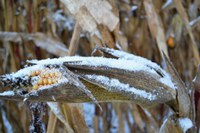Ag Producers Should Contact Insurance Agents if Harvest Delayed
(Click the image below to view a high-resolution image that can be downloaded)
Producers in several states, including North Dakota and Minnesota, have been affected by extremely wet and snowy conditions this fall.
“Impacted producers covered by crop insurance should contact their insurance agent as soon as possible to determine what actions they can take,” encourages Ron Haugen, North Dakota State University Extension farm management specialist.
According to the U.S. Department of Agriculture’s Risk Management Agency, producers should file a Notice of Loss and request more time to harvest before the end of the insurance period.
In North Dakota, the end of the insurance period is Oct. 31 for spring wheat and barley, Nov. 15 for sugarbeets and Dec. 10 for corn and soybeans.
Insurance providers may allow additional time to harvest, on a case-by-case basis, when all of these conditions are met:
- The producer gives timely notice of loss to the crop insurance agent.
- The insurance provider determines and documents that the delay in harvest was due to an insured cause of loss.
- The producer demonstrates that harvest was not possible due to insured causes, such as wet conditions preventing access to the field with equipment or that harvesting under such conditions would damage equipment.
- The delay in harvest was not because the producer did not have sufficient equipment or manpower to harvest the crop by the end of the insurance period.
If the insurance provider authorizes additional time to harvest, the end of the insurance period is not extended. Rather, the producer is granted additional time to attempt to harvest the crop to settle any loss based on harvested production.
Any additional damage to the insured crop during the extension period is covered, provided it is due to an insurable cause of loss such as excessive moisture. The producer’s crop insurance policy will cover loss of quality (as specified in the crop provisions), reduced yields and revenue losses if revenue coverage was chosen.
The cost of drying the harvested crop is not covered.
“If there is significant snow cover, if the crop is under water or if extreme wet conditions exist, it may be impossible for your insurance provider to perform final inspections to obtain accurate appraisals,” Haugen cautions.
Contact your insurance agent for more information on crop insurance issues.
For more information on delayed harvest options, visit https://www.rma.usda.gov/Fact-Sheets/National-Fact-Sheets/Delayed-Harvest---Wet-Conditions.
NDSU Agriculture Communication – Oct. 29, 2019
| Source: | Ron Haugen, 701-231-8103, ronald.haugen@ndsu.edu |
|---|---|
| Editor: | Kelli Anderson, 701-231-6136, kelli.c.anderson@ndsu.edu |


